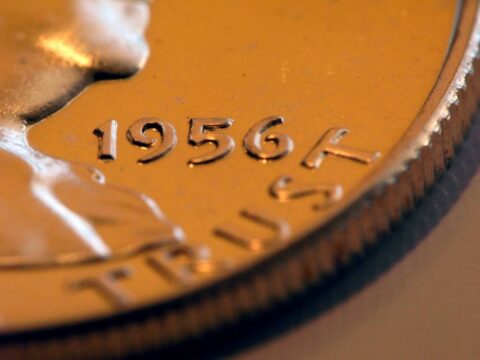
Many people think of coins as having two sides, but they really have three! The rim (or edge) of the coin is where some types of errors can also occur.
Coin rim errors make for some pretty fascinating discoveries by coin collectors.
The rim, which is the raised lip of metal around the periphery of a coin’s obverse (head’s side) and reverse (tail’s side), is prone to various types of errors.
How can you tell coin rim errors apart from common rim damage?
How much are coin rim errors worth?
What are the most valuable rim errors?
I’m going to answer these and many other questions about rim errors on coins in this article!

TIP: You’re going to need a good magnifying glass for examining coins close-up. You also need to be in good lighting (a 75- to 100-watt incandescent light is best).
Rim Damage vs. Rim Error
Before going into the various types of coin rim errors you may find and what they’re worth, it’s important to clear up the differences between rim damage and a bonafide rim error.
Unfortunately, most of the rim issues that folks believe are errors are really just forms of damage.
So, here’s a rundown of some of the rim oddities that may appear to be error coins but are just different types of damage:
- Dents, dings, and bruises — Virtually anything that goes into the rim is damage. This includes bumps, sharp cuts, and bruises.
- Flat rim or rim going into the lettering and/or design on the coin — Excessive wear can cause the rim to be worn flat and into the lettering and design elements around the periphery of the obverse or reverse. However, this is not an error, and coins with flattened or worn rims carry no extra value.
- Dryer coins or spooned edges — Ever see a coin where the rim is built up really high and appears to fold over the edges of the lettering, the design, or other details on the coin? This is a type of damage that can be caused by centrifugal forces experienced by a coin spinning around the inside of a clothes dryer. The folded edge can also be created by somebody who intentionally pushed the coin’s edge (the coin’s narrowest surface) and rim upward around the coin in a process commonly known as spooning. Either way, such pieces aren’t errors and have no additional value. An example of a dryer coin (or possibly a spooned piece) is seen in the image of this Indian Head penny:
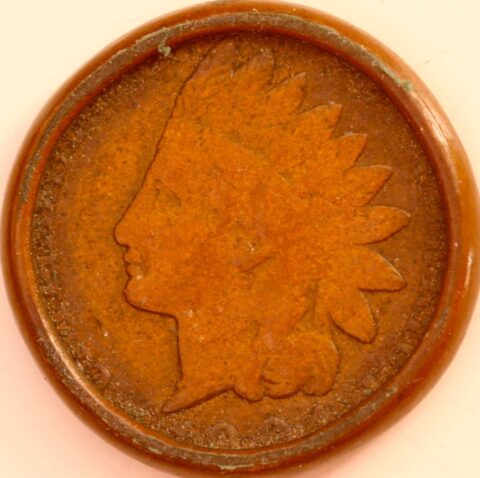
5 Types Of Coin Rim Errors… And How Much They’re Worth
There are several types of cool errors involving a coin’s rim.
Here’s a look at some of the most popular (and most valuable) coin rim errors:
#1 – Broadstrikes
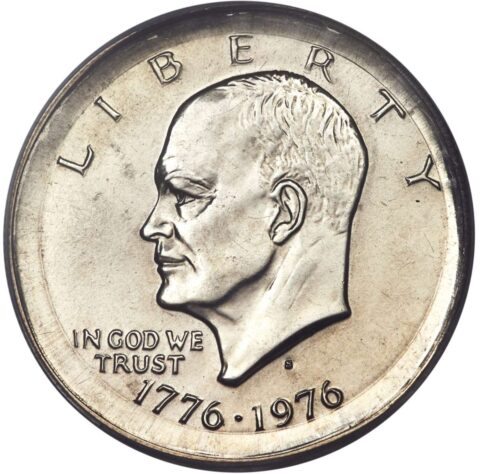
Coins are normally struck inside something called a retaining collar — which securely corrals the coin when being struck by the dies. The retaining collar helps form the coin’s edge and implants the thin vertical edge lines (known as reeds) on various coins such as dimes, quarters, and half dollars. These retaining collars also help shape the rim of the coin.
So, when the retaining collar fails to deploy as the coin is being struck, several things happen:
- The coin is stamped larger and flatter than ordinary
- The edge won’t be struck with the reeding or edge lettering as appropriate
- There will be no formed rim on the coin
Broadstrikes are unusual-looking error coins. They’re also among the most valuable types of errors directly affecting the coin’s rim. And they always have a plain edge.
Broadstrike error coin values vary depending on the piece.
Here’s what some of the most commonly encountered broadstrikes are worth:
| Coin | Value (USD) |
|---|---|
| Indian penny | $50+ |
| Lincoln wheat penny | $5+ |
| Lincoln Memorial penny | $5+ |
| Buffalo nickels | $250+ |
| Jefferson nickels | $10+ |
| Mercury dimes | $50+ |
| Silver Roosevelt dimes | $40+ |
| Clad Roosevelt dimes | $7+ |
| Silver Washington quarters | $150+ |
| Clad Washington quarters | $15+ |
| Franklin half dollars | $450+ |
| Silver Kennedy half dollars | $150+ |
| Clad Kennedy half dollars | $50+ |
| Morgan & Peace silver dollars | $500+ |
| Eisenhower dollars | $100+ |
| Susan B. Anthony dollars | $50+ |
| Sacagawea dollars | $250+ |
#2 – Off-Center Errors
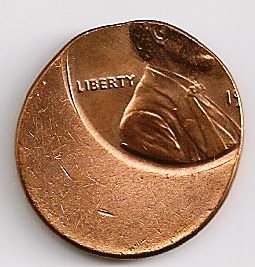
Off-center errors occur when a coin is struck outside of its collar and isn’t properly centered during striking. These errors may show the design 5% or 10% off-center… or perhaps as much as 60% or more off-center.
Many off-center errors cut off some or all of the date. But the most valuable off-center errors show the coin’s full date.
Values for off-center errors vary quite a bit.
Listed here are the values for coins that are approximately 15% to 50% off-center:
| Coin | Value (USD) |
|---|---|
| Indian penny | $75+ |
| Lincoln wheat penny | $7+ |
| Lincoln Memorial penny | $7+ |
| Buffalo nickels | $350+ |
| Jefferson nickels | $10+ |
| Mercury dimes | $250+ |
| Silver Roosevelt dimes | $125+ |
| Clad Roosevelt dimes | $7+ |
| Silver Washington quarters | $300+ |
| Clad Washington quarters | $50+ |
| Franklin half dollars | $1,350+ |
| Silver Kennedy half dollars | $350+ |
| Clad Kennedy half dollars | $200+ |
| Morgan & Peace silver dollars | $1,750+ |
| Eisenhower dollars | $300+ |
| Susan B. Anthony dollars | $200+ |
| Sacagawea dollars | $1,000+ |
#3 – Die Cuds
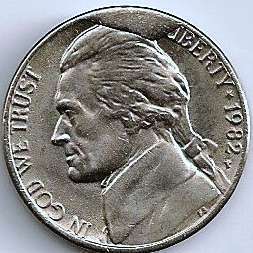
Have you ever seen a flat, slightly raised bump protruding from the rim onto the obverse or reverse? That’s a die cud!
A die cud is a type of die break that is attached to the coin’s rim.
Cuds are distinctive from other types of die breaks because they involve the rim and are typically large and flat. Most other die breaks are thin lines that generally occur on other parts of the coin.
Die cuds are among the most desirable types of die breaks and coin rim errors.
The value of a die cud varies — depending on the location, size, and overall appearance of the error. Because of this, it’s hard to give an exact value for a die cud, but most are worth about $100 or more.
#4 – Blank Coins
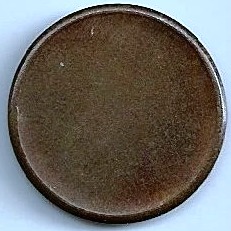
Many collectors find coins that are entirely blank and show no design at all. Although some of these blank planchets show light evidence of a rim, others don’t.
The pieces that are blank and don’t show any rim are more valuable than the finished planchets that have upset rims.
Here are the values for blank coins without the rim:
| Coin | Value (USD) |
|---|---|
| Bronze Lincoln penny | $3 |
| Copper-plated zinc penny | $2 |
| Nickel | $12 |
| Silver dime | $40 |
| Clad dime | $2.50 |
| Silver quarter | $150 |
| Clad quarter | $5 |
| Silver half dollar | $150 |
| Clad half dollar | $125 |
| Silver dollar | $1,500 |
| Eisenhower dollar | $125 |
| Susan B. Anthony dollar | $100 |
| Sacagawea dollar | $200 |
And here are values for blank planchets with an upset rim:
| Coin Name | Value (USD) |
|---|---|
| Bronze Lincoln penny | $2.00 |
| Copper-plated zinc penny | $1.75 |
| Nickel | $7.00 |
| Silver dime | $30.00 |
| Clad dime | $2.00 |
| Silver quarter | $100.00 |
| Clad quarter | $4.00 |
| Silver half dollar | $125.00 |
| Clad half dollar | $80.00 |
| Silver dollar | $1250.00 |
| Eisenhower dollar | $75.00 |
| Susan B. Anthony dollar | $80.00 |
| Sacagawea dollar | $50.00 |
#5 – Clipped Planchets
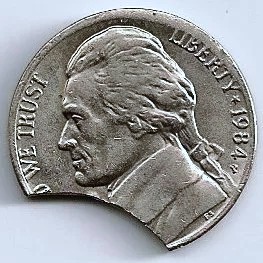
Sometimes errors occur in the process of stamping out the round blanks from the original sheet of metal. Among these errors are mistakes involving the round shape of the metal blank.
And every now and then, the cutting machine will mis-cut the metal.
One of the most common such coin rim errors are clipped planchets, showing a straight or curved (crescent-shaped) chunk of metal from missing from the edge of the coin.
In every case, part of the rim is missing from a clipped planchet error coin.
Here are values for various types of clipped planchet coins:
| Coin Type | Value (USD) |
|---|---|
| Bronze Lincoln penny | $2 |
| Copper-plated zinc penny | $3 |
| Nickel | $3 |
| Silver dime | $8 |
| Clad dime | $2.50 |
| Silver quarter | $15 |
| Clad quarter | $4 |
| Silver half dollar | $25 |
| Clad half dollar | $15 |
| Silver dollar | $50 |
| Eisenhower dollar | $30 |
| Susan B. Anthony dollar | $20 |
| Sacagawea dollar | $75 |




